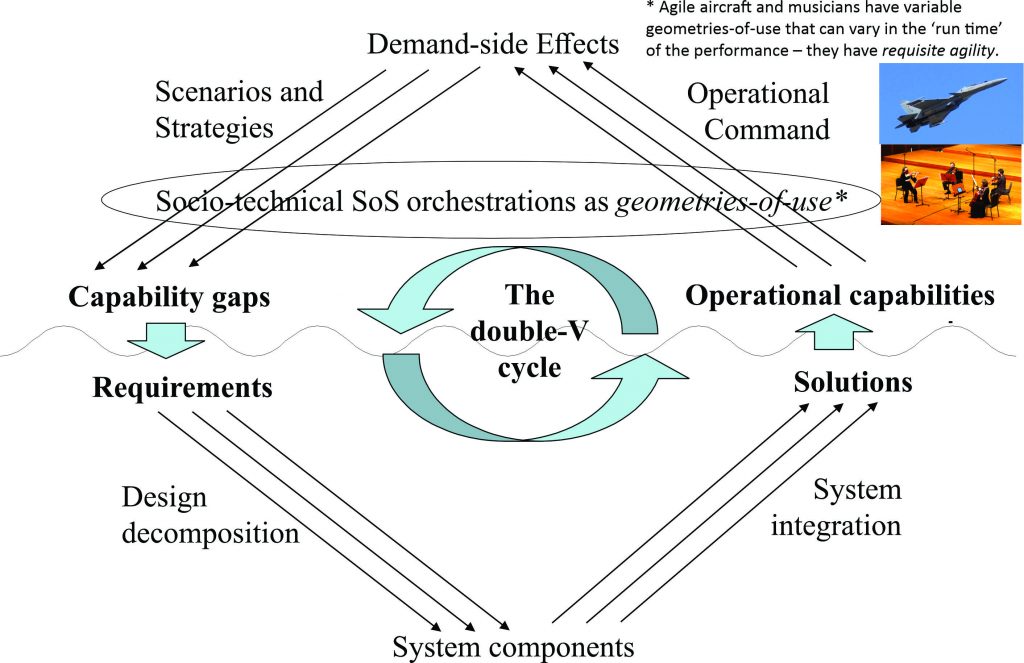by Philip Boxer
As demand tempo exceeds integration tempo, ‘design-time’ and ‘run-time’ become entangled[1], requiring a different approach to governance that needs to be East-West (horizontally) dominant[2]. It follows that the double-V cycle[3] becomes increasingly dynamic, addressing not just how capabilities are produced, but also how they are used.

- The bottom ‘V’ is about identifying a requirement, designing how it will be produced, and then producing it by integrating components. The provider captures value by being able to realize a solution from a defined requirement that can become an operational capability.[4]
- The top ‘Λ’ is about orchestrating a number of operational capabilities that can be aligned and synchronized in relation to a desired demand-side effect, enabling their combined use to cohere effectively within the client’s context-of-use.
Of course nothing ever works perfectly according to plan, so the after-action review and identification of gaps in desired performance leads back to new requirements of the bottom ‘V’ as well as to the need for new ways of orchestrating capabilities and making them cohere effectively at ‘run time’ in the top ‘Λ’.
The output-focused leadership of the bottom ‘V’ is familiar, while the effect-focused leadership of the top ‘Λ’ is less so. A new kind of challenge is presented, however, when the balance between both forms of leadership have to be held in the interests of cycling around the double-V as a whole[5].
In the following example, increasingly variable traffic and weather conditions is accelerating the tempo of demands made by the road traffic management system of a metropolis on a bulk salt provider.

- delivering truck-loads of salt to a depot comes down to having a good physical understanding of how to organize the extraction, production and delivery processes involved.
- The highly variable impact of ice and snow on the road transport system of a metropolis requires a situational understanding based on having information in as close to real time as possible not only about road conditions across all the different parts of the road transport system, but also about road use.
- Making effective use of this situational understanding depends on anticipating the effects of varying road traffic system demands on the rate of use of stockpiled salt. This involves developing a third kind of effects-based understanding through which the effects of operational decisions may be anticipated, decisions through which the desired operational effects on the road transport system may be sustained over time, driven by the way both traffic and weather conditions are varying.[6]

The management of weather-responsive traffic operations[7] thus formed the context-of-use for the bulk salt provider. With increasing variability in weather conditions through the winter months had come increasing variability in the demand tempo at which stockpiles had to be replenished. Failure to do so meant not only lost economic opportunities for the bulk salt provider but also huge adverse indirect effects for the metropolis of running out of salt on its roads. To avoid these adverse indirect effects, the accelerating demand tempo of traffic management operations demanded an accelerated tempo of operations for the bulk salt provider: the bulk salt provider also had to start managing the top ‘Λ’.
The means open to the bulk salt provider for dealing with this accelerated demand tempo was changed with the emergence of an FAA-approved operator of automated drones – American Robotics. From the perspective of American Robotics,
“at the end of the day, our industry’s product is data, not aircraft. With true automation comes the ability to collect a new category of data not previously possible, resulting in a new category of valuable analytics and insights.” Stockpile Reports selects American Robotics
American Robotics drones could be used by Stockpile Reports to enable the bulk salt provider to leverage an automated drone program in multiple ways:
- To avoid financial write-offs due to a lack of accurate inventory data;
- To scale real-time digitization of large industrial stockpiled materials;
- To totally change assessment and management of inventory.

The demands on the bulk salt provider thus presented a market opportunity for Stockpile Reports:
“The bulk materials industry suffers chronic financial write-offs due to a lack of accurate inventory data, and Stockpile Reports helps customers solve problems with inventory using on-demand measurements from image processing … as experts in 3D reconstruction and digitization, we know what it means to dance on the edge of innovation. … With more than 10,000 sand and gravel mines in the U.S. alone … Autonomous drones completely change the business case … we can increase the frequency without substantially increasing the costs … you can take those inventory counts on a monthly, weekly or even daily basis. That takes you out of operations and into supply chain management… “
Stockpile Reports could enable the bulk salt provider to capture economies of alignment[8] in the way it was able to make bulk salt available to road traffic management systems at an accelerating demand tempo. The value it could capture was from changing how the bulk salt provider organized the upper ‘Λ’ through more dynamic supply-chain management, thereby enabling the bulk salt provider to create value in the way it provided more timely services to the traffic management system.
What we see in this example is a new technology (drones and 3-D imaging) changing the ways in which a (bulk salt) provider is able to manage an accelerating demand tempo (driven by increasingly variable weather and traffic conditions) within its client traffic management systems as contexts-of-use.
The point is that the need of the metropolis to manage the top ‘Λ’ of the traffic management system generates effects all the way back up the relevant delivery, production and extraction sectors of the economy. The ability to manage the top ‘Λ’ is demanded of the bulk salt provider in addition to the physical understanding demanded by the bottom ‘V’. In this example, the digitalization made possible through a new kind of service provider (Stockpile reports) enabled the bulk salt provider to develop greater situational understanding, enabling it to be driven by the accelerating tempo of the effects its service could have has on the effectiveness of the traffic management system.
[1] This entanglement being the defining characteristic of ‘wicked’ problems.
[2] In East-West dominance, the North-South vertical axis is understood a creating the limiting conditions on how responsive the horizontal axis can be.
[3] The rate at which this cycle has to be navigated depends on the kind of value the organization is trying to capture.
[4] An operational capability that can be used as part of a socio-technical system-of-systems (aka geometry-of-use) depends on the processes of the organization described by the development wheel.
[5] If the demand tempo being faster than the integration tempo can be ignored, then the provider can separate design time from run time and adopt a one-sided relation to demand in its approach to governance.
[6] See, for example, managing traffic operations during adverse weather events.
[7] See, for example, Concept of Operations for Weather-Responsive Traffic Management.
[8] Whereas the bottom ‘V’ is sufficient to capture economies of scale and scope, the top ‘Λ’ is necessary to capturing economies of alignment.